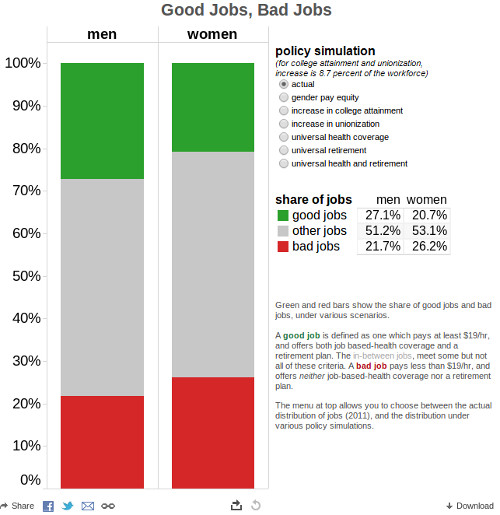May 02, 2013
This post originally appeared in Dissent Magazine. Colin Gordon is a professor and director of Undergraduate Studies, 20th Century U.S. History, at the University of Iowa.
What happened to the good jobs? This is the question posed by the walkouts of fast food workers in New York and Chicago in recent weeks. It is the question posed by activists in those corners of the economy—including restaurants and domestic work and guestwork—where the light of state and federal labor standards barely penetrates. And it is the question posed (albeit from a different set of expectations), by recent college graduates for whom low wages and dim prospects are the dreary norm.
There are no shortage of suspects for this sorry state of affairs. The stark decline of labor, now reaching less than 7 percent of the private sector, has dramatically undermined the bargaining power and real wages of workers. The erosion of the minimum wage, for which meager increases have been overmatched by inflationary losses, has left the labor market without a stable floor. And an increasingly expansive financial sector has displaced real wages and salaries with speculatory rent-seeking.
New work by John Schmitt and Janelle Jones at the Center for Economic and Policy Research recasts this question, posing it not as a causal riddle but as a political challenge: What would it take to get good jobs back?
Schmitt and Jones start with a basic distinction between good jobs (those that pay $19.00/hr or better and offer both job-based health coverage and some retirement coverage) and bad jobs (those that meet none of these criteria). Each of these categories accounts for about a quarter of the workforce (the rest fall somewhere in between), with the share of good jobs slipping since 1979 and the share of bad jobs creeping up. The goal, by simulating the impact of different policy interventions, is to increase the share of good jobs and to eliminate—as much as possible—the bad jobs entirely.
Some policies—however salutary—would have little impact on this “good job-bad job” distribution. Raising the minimum wage, for example, would boost the earnings of 30 million workers, but it would do so by transforming bad jobs into not-quite-so-bad jobs. A worker earning $10.00/hr without benefits, after all, is still pretty far removed from a good job.
The graphic below summarizes the findings of Schmitt and Jones, for men and women, for five policy changes. Gender pay equity, not surprisingly, would yield some small gains for women—a slightly higher share of good jobs, and a slightly share of bad jobs. An increase in college attainment yields only a modest improvement, a finding consistent with other research suggesting that wages are falling despite increasing educational attainment (and not because there is some “skills” mismatch between available workers and available jobs).
Click Image for Interactive Graph
There is a stronger payoff for collective bargaining (simulating a 25 percent increase in union density instead of a 25 percent increase in college attainment), which yields not only a union wage premium but higher rates of job-based health and pension coverage. But the returns here are not as big as one might expect, probably because labor’s ability to deliver such benefits to its members has fallen alongside its share of the workforce. Simply bumping up the union density rate, in other words, is not the same thing as reclaiming the labor movement of last generation.
The strongest payoff comes with socializing and universalizing health and retirement coverage. Adopting either would erase the bad jobs entirely. Adopting both would push the share of good jobs to nearly half (50 percent for men, 39 percent for women). This resonates with our understanding of the perverse logic of job-based social policy—which tends to widen inequalities (good jobs, after all, are the ones with good benefits) rather than close them. It resonates with our understanding of the broader benefits of universal social policy—which wipes away not only the waste and stigma associated with risk-rating and means-testing, but the crushing insecurity of going uncovered or uninsured. And it resonates with our political and economic realities, in which incremental progress on social policy (maybe just in the states) seems more likely than a surge in labor organization and more resourceful than deep personal investments in education.







